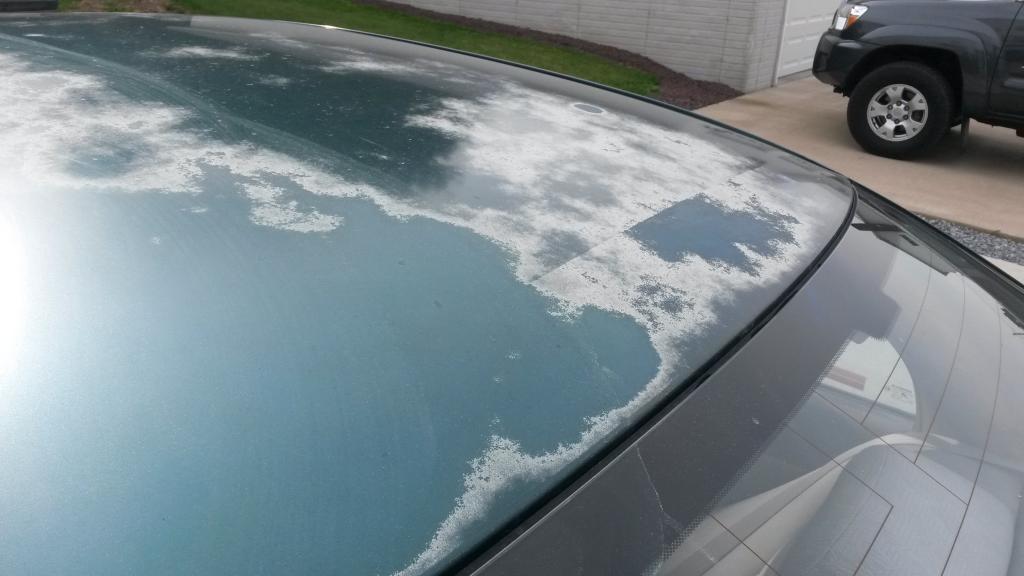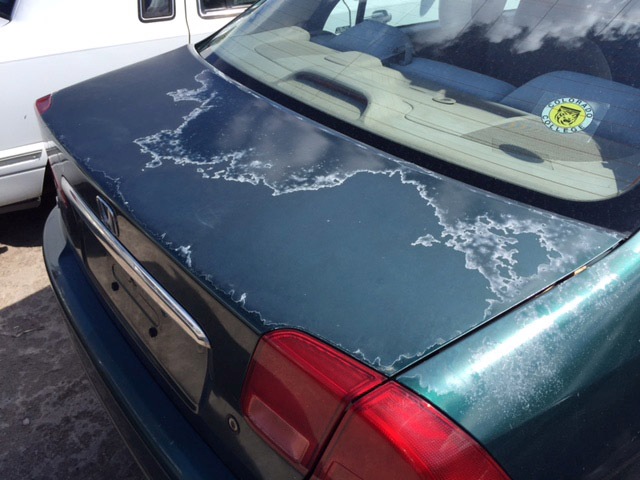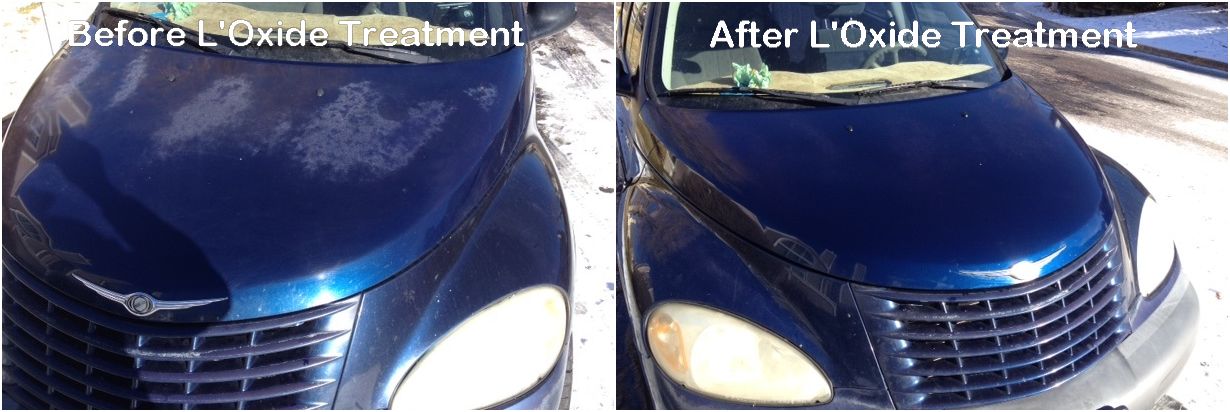Using the wrong solutions and tools to clean the car can result in the car paint color fading if they are used over extended periods of time. Not every type of cloth is suitable for cleaning a car's paintwork even if it is heavily soiled. Do not, under any circumstances, use a scouring style pad or cloth to clean the car as this can result in you removing layers of paint. In addition, always make sure that you use a cleaning solution that is specifically manufactured for the purpose of cleaning cars.
Avoid any products that contain an array of chemicals. Maintain the wax job to the car's paint job to reduce the need for cleaning. A decent wax will prevent debris adhering to the car so that you do not have to undertake any unnecessary cleaning. Even when the sun doesn't appear to be that bright, the ultraviolet rays can still remain powerful and can cause the car paint color to fade.
The sun's rays degrade the finish of the paintwork which is designed to protect it. This then leaves the paint exposed and susceptible to damage and fading to the color. With the sun comes the heat, which is absorbed and stored in the metal of the car's bodywork and can also be the cause of fading and discoloration.
If you find the problem mainly affects the roof, hood, and boot then this is likely to be the cause. Wherever possible, avoid parking the car in direct sunlight and store the car within an enclosed garage or covered port if you have the facility. Prolonged exposure to UV rays will damage your auto body paint by speeding up the process of oxidation. One way to prevent paint fading is by keeping the car out of direct sunlight as much as possible.
Try to park in a covered garage, in the shade, or a car park. If you can't find an enclosed or covered space to park your car, use a car cover to protect the auto body paint. One of the ways to protect the paintwork of the car from the sun's ultraviolet rays is to follow up the washing and drying of the bodywork with a polish and wax finish.
Remember to use a good quality wax which can be bought from a number of automotive outlets and ensure you don't skimp on the waxing. Waxing will add an extra protective layer to the paint and help prevent UV rays from penetrating and discolouring the surface. When waxing and polishing, remember to check for any dints and dents as you work across the surface.
Simply hand wash the panels to be treated and allow to dry. Your car's paint job can have a significant impact on its overall look. We often choose colors that make our cars look sleek, stylish, or unique. However, that vibrant tone can sometimes begin to fade over time.
When this happens, you may need to visit your local auto body shop to discuss your repainting options. However, if you understand what the main factors are that cause fading, you can prevent the need for a new paint job for as long as possible. But sometimes both of these aren't as accessible for all vehicle-owners!
First, make sure to park your vehicle in a garage or covered location as often as possible. Second, wash and wax your vehicle regularly and properly. Using wax after washing is an essential step to help protect the coating of the paint. No waxes, rubbing compounds, polishes, clay bars or buffing machines. Just an easy wash and dry followed by an application of our unique liquid emulsion for instant results.
It takes a little extra time, but applying wax to the car will help protect the paint job. Use a car wax that is specifically formulated to prevent UV damage. This type of product should be applied at least once every season and more often if you live in a climate that gets lots of sunshine. Auto experts recommend using paste or liquid wax as it provides better coverage and lasts longer than spray wax products. Washing your vehicle regularly is always good basic car care.
You should avoid doing this in direct sunlight and be sure to use special car wash products. Avoid using dishwashing soap or household cleaning detergents because these products can strip the paint of oil and its protective wax coating. Once it's clean, dry the surface of your car thoroughly.
Heat and sunlight cause fading and, in some cases, the paint to bubble and crack which not only ruins the look of the car, but can cause rust damage in the long run. The paintwork acts as a protective skin over the metal frame stopping water and oil residue getting into the metal structure where rust can form. Washing the car on a regular basis will not only remove dirt and debris that can scratch the surface of a car but also other more harmful elements as well. Bird droppings consist, amongst other things, of uric acid in minute quantities.
If these droppings are not removed from the car then the acid can start to damage the paintwork. Plus, the sun on the faeces causes the chemical reaction to work even quicker, so get them washed off as soon as you have spotted them. If the damage has already occurred, contact your local car paint match repair shop and get it sorted out before any more problems occur.
Now that the paint damage has been buffed out, it's time to apply the paint protection product. You can use car wax, paint sealant, or ceramic coating. Car wax only provides a few months of protection, so if you choose this route, you'll need to make sure to keep your vehicle clean and repeat the waxing often. Paint sealant is applied in a similar process to wax but lasts upwards of six months. Ceramic coating application requires a bit more knowledge but provides up to two years of protection.
Applying this coating adds a microscopic layer of ceramic coating, which is very heat resistant, and harder than the other two options. Adding this coating will help enhance the appearance of your vehicle. You can prevent sun damage to car paint by keeping your vehicle inside a garage, under covered parking or in a shaded area when it's not on the road.
By not leaving it to bake in the sun, you'll also protect the headlights and rubberized trim from damage. The sun's ultraviolet rays can contribute to car paint oxidation, a process that occurs when heat and oxygen come together to damage a vehicle's exterior. Over time, heat from the sun's UV rays causes a car's paint coat to dissipate. As a car's paint heats up, oxygen penetrates the paint. This enables the metal beneath the car's paint to absorb heat, which results in fading. Direct sunlight can degrade the finish of your car's paint over time.
You'll likely notice that the areas that are fading tend to be more pronounced on the top of your vehicle. This issue is not easy to avoid since UV rays are still present on overcast days. However, you can prolong the life of your paint job by parking in a garage or under shade as often as possible.
The sunlight has ultra-violet, and has absorbed some of the pigments. Blue metallic colors sometimes shift to a greener shade, and reds will turn pinkish or more orange. The auto body shop has to deal with matching an oxidized color in addition to new OEM colors.
The new paint to be applied will look brighter and cleaner but the rest of the car looks dead even if you polish it. Faded car paint is the last thing that's on a new-vehicle owner's mind. Unfortunately, due to environmental and other factors, your vehicle paint can start fading within as early as two years. This is more common in locations with harsher elements, but nonetheless, something every vehicle owner should be prepared for. In this article, you'll learn why auto paint fades, how to prevent auto paint fade, and how to fix faded paint.
If you were to walk around the parking lot of a popular grocery store, you will most likely see that many cars, SUVs, and trucks have car paint that is fading. If you want an extra level of car paint protection, a good wax job can go a long way. Waxing plays a major role in keeping your auto body paint and finish in excellent condition. When it comes to your car's paint, prevention is key, and your vehicle needs a deep clean to protect the top coat from any existing and future damage. Regular washing helps prevent grime, bird droppings, and dirt from sticking to the paint job and damaging it. This same schedule helps you protect your car from the sun and other environmental factors.
It is not just the paintwork that will be protected but the interior as well when you keep the vehicle away from the harmful rays of the sun. Avoiding direct sunlight will keep the bodywork of the car from cracking and fading. If this does happen, then secure the services of a car paint match specialist who can source the factory colour paint and carry out a respray so the vehicle looks as good as new. If you cannot find a shady place to park, then consider buying a good quality cover to put over the car while it is parked out in the heat. Otherwise when you have finished using the car for the day, park it in the garage or under a roofed drive to keep it looking as new as the day you bought it.
Darker colored vehicles are more prone to sun damage and car paint oxidation, due to temperature extremes where the vehicle is not garaged or otherwise covered. If you live near the ocean, you may find that salt in the air can be problematic and can cause your car paint color to fade. If salt is allowed to remain on the surface of the paintwork, you will find that the result will be oxidization. This can not only cause the paint to fade, but will also damage it to the point where it peels and rusts the surface beneath. This problem can be prevented with the use of a regular and effective method of cleaning and waxing to create a surface that salt cannot stick to.
To prevent your paint from fading, it's best to park your vehicle in a garage or shaded area whenever possible. If you don't have a garage or shade to park under, you may want to consider using a car cover. Since various impurities can damage the paint over time, you should also have your car professionally washed and waxed every few weeks. Investing in some paint protection can protect your car much more than you realize. Some drivers invest in auto paint protection film kits for their entire car, which is good, as it's taking the protection a level higher than waxing.
When you use the right product for your vehicle, you can restore your Toyota factory finish faster, not to mention easier than any other way you want to try. All vehicles from Toyota have paint codes that match a certain color, which is what makes them so easy to find and match. You might not need to use touch up paint on the entire car.
Maybe it's your hood or scratches here and there that need more attention. To prevent car paint fading, you should park your vehicle in a garage or shaded area whenever possible. You should also get your car professionally washed and waxed every few weeks or any time your vehicle's exterior looks dirty.
Third, and most effectively perhaps, is the benefits of waxing your car. If you don't have an orbital waxer, good old fashioned elbow grease will do, but prepare to feel the burn in your arms the next morning. Wax provides excellent additional protection by filling in tiny imperfections and smoothing paint, but like everything – exercise caution. Over-waxing can cause build-up on your car's surface, which is equally as unappealing.
Single stage paint jobs are, therefore, at risk of paint fade and oxidization before that of clear coated paint jobs. They can develop an unsightly faded pink look to them over time due to the sun stripping the paint of its moisture and oils. Modern automotive finishes are more resistant to oxidation than those of the past. Older vehicles had a tendency to fade significantly from oxidation; a red car could turn pink, a black one to a dull grey. Some of the damage can be from the ultraviolet rays of the sun breaking down the paint's pigment, but oxidation is also a culprit.
Oxidation can appear on the entire surface, or it can show up in patches. It is most prevalent on the top surfaces - the roof, hood, and trunk lid - since the ultraviolet rays exacerbate the condition. Much in the way that spinning plastic brushes at a car wash can lead to a dull car paint job, improper hand-washing can negatively affect a vehicle's luster.
Car owners who use hard bristle brushes when they wash their vehicle's exterior may cause damage that leads to dulling. Additionally, applying certain soap types to a car's exterior can also contribute to a dull paint job. All too often, we're told by customers or friends that their faded paint job meant having to repaint the whole thing. This is likely the response from a paint garage, or technician.
Restoring this layer of moisture in the paint by adding a wax, essentially replacing a layer of protective lacquer, should protect and restore the colour. Depending on how serious the damage is, you may not need to have your car brought back to its shiny best at a garage. If you notice the early signs of paint oxidation, it's best to act fast. Like with rust, the longer the corrosion is allowed to continue, the worse the paint damage becomes.



























No comments:
Post a Comment
Note: Only a member of this blog may post a comment.